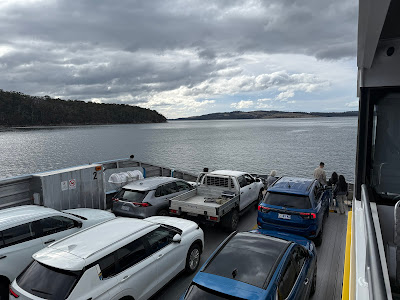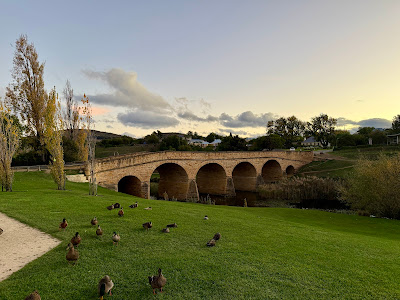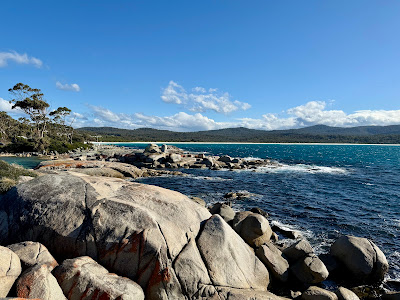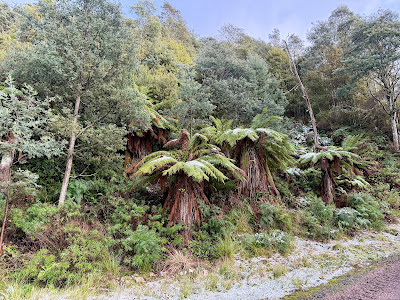Movenpick by the way takes its name from the seagull (Moven) and its picky way of eating. That doesn’t seem the best of ways for naming your hotel chain but thankfully most of the world don’t know the etymology.
We walked around the central area of Hobart. It is a relatively small and compact city when compared to Sydney and Melbourne and the central district can be covered in an afternoon.
 |
| Customs House, Hobart |
First we went into the tourist office to ask for advice on what to see, what to do in Tasmania. We had ambitious plans, but the agent in the office was doubtful that’s we could travel that far in just 5 days. I don’t think that she was fully aware of what an active pair of 70 yr olds we were.
 |
| Salamanca Market, Hobart |
We went over to the Salamanca Market Square and walked around the shops. The larger market with all the stalls was not open while we were there but apparently when it is, it is quite a popular destination for tourists and residents alike. The market was named after Duke of Wellington’s victory over Spain in the Battle of Salamanca. It is surprising how many references there are to the colonial past and to British military battles in Australia. The early colonists must have closely followed what was going on militarily and politically back in the old country.
 |
| Hobart Harbor |
After the market, we walked up towards the government buildings and then back down to the harbor once more.
 |
| Monument to Women Deportees |
There were a couple of monuments in the harbor area - one to the women that were transported to the penal colony in Tasmania, the other to Antarctic exploration, in particular to the exploits of Douglas Mawson the geologist and explorer. Mawson had a most interesting life. He was on Shackleton’s Nimrod expedition, he declined to join Scott’s expedition, he led his own expedition and had a near death experience before then serving in the British Army during World War I. What a life.
 |
| Monument to Mawson’s Antarctic Expedition |
That evening we dined in the hotel and studied the maps to plan our journey for the next few days,
The next morning after breakfast we took an Uber back to the airport to pick up a car. All they had was a huge Ford Expedition Diesel. Larger than we reserved or wanted but we got used to it and really enjoyed all the space.
 |
| Ferry to Bruny Island |
Our first destination was to Bruny Island. We drove to the town of Kettering from where the Bruny Island ferries depart. There was quite a line of cars and we couldn’t get on the first one. We didn’t have long to wait for another one - the two ferry boats run continuously and it is only a 10 minute journey
 |
| Bruny Neck |
On Bruny we drove south to Bruny Neck, the thin isthmus of land that separates North and South Bruny Island. At the Neck there is a causeway that has been built over from the road to the beach and another up to the top of the hill and the Troganini Lookout from where there is a great view to South Bruny. The Neck is the breeding site for Short Tailed Shearwaters and Fairy Penguins. Unfortunately, in late April, neither of these birds are in residence so we had to make do with the fine views.
 |
| Cape Bruny Lighthouse |
 |
| Cape Bruny |
We drove south through beautiful countryside and through the small towns of Alonnah and Lunawanna. From there we took the dirt road to Cape Bruny Lighthouse at the southern end of the island. The eucalyptus forests were dense and lush and the beaches were just gorgeous if a little chilly. At the southern end of the island there were impressive columnar basalt cliffs.
 |
| Coal Point Conservation Area |
On the way back north to the ferry we diverted out to Adventure Bay and the beach at Coal Point Conservation Area. The beach was beautiful and deserted with the eucalyptus forest coming right down to the waters edge.
 |
| Richmond Bridge |
We took the ferry back to the mainland, or at least mainland Tasmania, and then drove north through Hobart and out the other side towards Richmond. The guidebooks indicated Richmond was a town that tourists visit. However, late in the afternoon, as the sun was setting, it was pretty quiet. The bridge over the Coal River is very beautiful and it is the oldest bridge still in use in the whole of Australia. The town also has the oldest Anglican Church and the oldest Catholic Church in Australia. Not bad for a little unassuming town.
 |
| Richmond Anglican Church |
There was little else happening in the town. All the shops were closed and all the restaurants except the Richmond Hotel were closed. We dined at the Richmond Hotel. Good bar food - a typical Australian pub I think.
We drove over to the town of Sorrel where we were staying for the night. The hotel was a modern hotel on a winery. It was trying a little too hard to be high tech - fancy air con fan that somehow couldn’t be turned off, a motion sensor in the bathroom that turned on the full bright lights anytime you walked in - not what you want in the middle of the night, a night light would have been sufficient. First world problems.
The next morning we got to explore our hotel a little more - it is really a resort type hotel for weddings and the like. They have a vineyard, an orchard and animals (sheep, llamas, goats). A nice setting but the room was a little unfriendly.
We drove north to Orford where we stopped for breakfast - a latte and a cake served by a very friendly woman - the Australians are generally quite a friendly lot.
 |
| Mayfield Bay and Beach |
We then drove further north on the coast road, stopping at various beaches along the way - Raspins Beach, Rocky Hills Beach, Mayfield Beach. We drove to Coles Bay and into Freycinet National Park. There were some nice rock exposures in the park - reddish pink granites or metamorphics maybe. The beaches were many and beautiful.
 |
| Binalong Bay |
 |
| Welcome to Binalong Bay |
Further north, we visited Binalong Bay, a town that has a statue of a young bikini clad woman at its entrance - not sure what they are trying to promote with that. From Binalong you can look north towards the Bay of Fires. This entire area is a beautiful coastline - nice rock formations, beautiful yellow sand, nice blue sea.
 |
| Black Swan |
We then turned back westwards towards Launceston. On way in the town of St Helen’s we saw our first Black Swans. I always thought they were quite rare but after our first sighting we saw many more. A beautiful bird.
 |
| Launceston |
We arrived in Launceston just before sunset. Launceston is the second largest city in Tasmania. It has many claims to fame - the first Australian city with an underground sewer, the first Australian city powered by hydro-electric power, and weirdly, the first place where an anesthetic was used in the southern hemisphere. We parked and walked around the town - many nice old buildings, nice churches, but it was the end of the day and most things were closed.
We drove further west towards the Cradle Mountain area stopping in the town of Deloraine for the night. We found a nice little hotel, rather basic, but very friendly, staffed entirely by young cheerful Asian ladies. The same ladies ran the hotel restaurant where we dined. When the staff have a good attitude it spreads to your attitude and you are more tolerant with a few minor issues.
It rained quite heavily in the night but the next morning it was a beautiful clear day. We checked out and drove through Deloraine which turned out to be quite a nice town.
 |
| Award Winning Pies in Deloraine |
We stopped for breakfast at a bakery/coffee shop that advertised its “award winning pies”. They looked wonderful and they tasted really good.
 |
| Sculpture in Deloraine |
The Meander River flows through the town and there was an interesting sculpture in the park adjacent to the river flowed through- a pretty town.
 |
| East of Deloraine towards Cradle Mountain |
We drove west towards Cradle Mountain. The rain we experienced in the night must have fallen as snow in the highlands and there were great views of the mountains to the south of the road with a dusting of snow on them.
 |
| Snow on ferns and eucalyptus near Cradle Mountain |
As we got higher into the mountains the forests became more dense with tall eucalyptus and ferns. Then we got into the snow. The roads were clear but there was snow in the trees.
We approached Cradle Mountain National Park and stopped at the lodge for a break. We went inside and got warmed up at the side of the fire with a nice cup of cocoa. It was fairly chilly up high and it was raining intermittently. Not the best of days so we didn’t explore any further and we drove on towards Queenstown.
There were signs that the area would be quite spectacular on a nicer day but sadly the weather didn’t cooperate when we were there.
 |
| The West Coast Wilderness Railway |
We stopped in Queenstown to get more diesel. Just as we finished re-fueling the tourist steam train came into the station. The West Coast Wilderness Railway is a cog railway that runs a few miles out of Queenstown up into the hills. The engine built in Glasgow in the late 1800’s is a thing of great beauty.
 |
| The Hunter’s Hotel, Queenstown |
Queenstown was the center of gold mining in the area in the late 1800’s. Since the demise of mining in the area it has become dependent on the tourism industry.
We left Queenstown and continued our drive south. On an overlook above the town we talked with a motorcycle rider who was looking a bit cold and weather beaten. He was the lead motorcycle in a group of some 160 riders. For the next 2 or 3 hours we continued to pass motorcycles coming towards us.
 |
| Hydro Electric Plant on the Neve River |
As we descended down hill we passed several hydro electric plants. About 80% of Tasmania’s electricity comes from hydro generation.
 |
| Near Ouse, Tasmania |
As we got further down into the lowlands the weather became milder and the skies were blue. The forests gave to grassland and sheep and cattle grazing. We drove into Hobart as the sun set and once more checked into the Movenpick hotel. After a long day of driving we were too tired to look for a restaurant so we dined in the hotel.
 |
| The catamarans for the trip to MONA, Hobart |
| The next morning we had a reservation to visit the MONA gallery. MONA stands for Museum of Old and New Art. This included a boat ride from Hobart over to the nearby Berriedale Peninsula. We were at the dock 9:00 to board the high speed catamaran over to the gallery. It was about a 20 minute journey. |
The museum is the creation of David Walsh, a man that made a large amount of money from gambling, particularly gambling on horse racing. Somehow he developed a system that allowed him to accumulate significant winnings from racing. Apparently he won over $16 million Australian from one Melbourne Cup meet.
 |
| A bar three stories down below the ground, MONA |
 |
| A labyrinth of walkways and stairs, MONA |
Arriving at the museum you walk up a series of steps and step inside the entry. You then descend three stories down a spiral staircase into the bowels of the museum. There are three floors of large galleries all below ground connected by a labyrinth of passages and walkways. You work your way from the bottom to the top and the exit. There are no identifications on any of the art pieces, you can only determine what you are looking at by using a phone app.
 |
| Observing the activity in the brain - MONA |
 |
| Sacrificial Horse - Berliner de Bruyckere |
 |
| Whitehouse - Ai Weiwei |
It is a most interesting gallery - some pieces shocking, some pieces disturbing, some pieces old and conventional, many modern and controversial. There was a Damian Hurst painting made of dead flies, a model of a dead horse hanging by a strap around its belly, a large head with view ports in the skull where you could look inside the brain to see light flashes, birds flying around and all sorts of frenzied behavior, the odd Picasso, a giant Sidney Nolan Mural, an Ai Weiwei installation of a wooden Qing Dynasty house mounted on glass spheres, a fat shiny red Porsche.
 |
| One of the larger galleries at MONA |
We paid a little extra to go through a piece called Dante’s Inferno by Alfredo Jaar. Based on the Divine Comedy it was three separate rooms - Hell, Purgatory and Heaven. In the first one you have to wear a safety harness and take of anything that might fall off into the exhibit (a swirling cauldron of water). It is a combination of heat from heaters above your head that get progressively hotter and closer and a swirling cauldron of water that slowly fills up beneath you. The Purgatory room was a video of an old woman acting out her own death beneath a bed on a floor of dead leaves and twigs. The heaven room was, not surprising the most pleasant. An anechoic chamber with blue sky and a beautiful cloud of white vapor descending from the ceiling. You can hear your heart beat in the total quiet of the anechoic chamber.
 |
| Unknown Artwork - Outside MONA Gallery |
 |
| Outside MONA Gallery |
We spent a good 4 or 5 hours working our way up to the top of the gallery and the exit to the grounds outside. It is all in a beautiful setting close to the water and with an adjacent vineyard. Around 3:00 in the afternoon we made our way to the boat dock and our ride back to Hobart.
 |
| Hobart Harbor from the water |
Hobart is a beautiful city, especially when approaching from the water. An impressive modern bridge over the wide Derwent River estuary, the houses stretching up the hillside from the central district near the harbor.
Back in Hobart we had another coffee and cake break at a cafe near the Salamanca Market. Then it was to the hotel to pick up our car and drive out of town for our last night in Tasmania.
We were staying near Port Arthur a penal colony where in the early 1800’s many prisoners exiled from the UK were imprisoned. We were staying at Stewarts Bay Lodge, a collection of cabins adjacent to the ocean. What we didn’t know at the time was that the lodge was the next development south of the Seascape resort where in 1996 a gunman killed 35 people and wounded 23 - Australia’s largest mass killing that sparked a radical change in Australia’s gun laws. If only the USA could respond in a similar way to their all too frequent mass killings.
 |
| Stewarts Bay at Sunset |
We had a nice cabin on the property and we walked down to the beach to witness a beautiful sunset. That night we dined at the only restaurant in the area, in our lodge complex. A great meal of another new fish - the Gem fish.
 |
| Crab Carnage on the Beach |
The next morning I got up early for a sunrise run on the beach and was surprised to see hundreds and hundreds of dead and dying crabs on the beach. They were not there the previous night so they must have washed in on the tide that night. Every now and again there was a live one slowly writhing in the throws of death. Other than that the sunrise was quite beautiful.
We were on the road early to investigate the Port Arthur Gaol site. Unfortunately when we got there we found it didn’t open until 9:00 and it was only 7:30. Fortunately a man who was emptying the garbage bins saw our frustration and told us of a back door into the property - a road down to a boat dock that was not gated. We drove down and we were able to walk around the site before it was open to the public - very nice.
 |
| Port Arthur Penal Colony |
The main gaol is an imposing building built out of the beautiful local sandstone, more like a decaying stately home than a prison. It was hard to imagine the what cruel acts took place there when it was such a wonderful setting - by the side of the bay, with green lawns and eucalyptus forests.
 |
| Port Arthur Penal Colony Church |
Adjacent to the main gaol there were decent looking buildings for the wardens and staff and a rather fine looking church.
 |
| Maingon Bay |
We then drove south on Safety Cove Road and stopped off to look at some nice coastal rock formations. One was a lookout over the beautiful Maingon Bay. The other was a site called the Remarkable Cave. It was interesting but not worthy of the name “remarkable”.
 |
| Rock Arch at Eaglehawk Neck |
We then drove on a little loop road around the peninsula, through Nubeena, Premaydena and Taranna. We then investigated a couple more interesting coastal rock formations near Eaglehawk Neck.
 |
| The Dog Line - Eaglehawk Neck |
Eaglehawk Neck is a very narrow isthmus of land that separates the southern part of the peninsula. It is less than 100 ft across. In the times of the penal settlement in Port Arthur, this was a good defensively line to catch any escaped convicts. A line of some 9 dogs was set up across the isthmus. The fierce dogs were positioned close enough to each other that they could almost touch but they could not fight each other. Any disturbance in the area would set the dogs barking and bring out the guards. When prisoners started to swim around the dog line they placed dogs on platforms out into the sea.
 |
| The Tesselated Beach |
The next stop was a beach with an unusual rock pattern. The Tesselated Beach eroded such that there was a pattern similar to a pavement.
That was our last stop of our Tasmanian tour. We drove to the airport, handed in the keys to our car and caught the Jet Star flight to Melbourne.
No comments:
Post a Comment